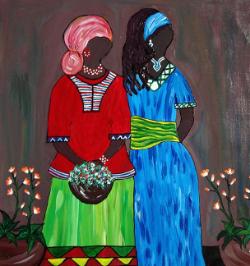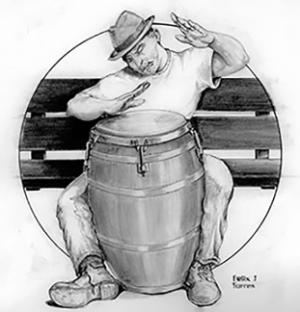October 23, 2015
Latin Beat: Art and Culture at SUNY Empire State College
 (NEW YORK CITY - Oct. 23, 2015) SUNY Empire State College presents "Latin Beat: Art and Culture," a multimedia exhibit showcasing the work of current students and alumni sharing their views, experiences and contribution to the Latino culture.
(NEW YORK CITY - Oct. 23, 2015) SUNY Empire State College presents "Latin Beat: Art and Culture," a multimedia exhibit showcasing the work of current students and alumni sharing their views, experiences and contribution to the Latino culture.
The exhibit is at the Livingston Gallery, sixth floor, 177 Livingston Street, Brooklyn, through Dec. 15, Monday through Thursday. Admission is free. Raúl Manzano, college faculty mentor and gallery coordinator, is the curator of the exhibition.
“Celebrating Hispanic Heritage is a way to think not only about our roots, but also to open our minds to the evolving changes in humanity. Even though cultures have their own unique identity, they also are a cross-section of races and cultural backgrounds,” says Manzano. “SUNY Empire celebrates its cultural diversity. This exhibition brings together Latinos from the American continent. We invite you to join us and celebrate the vibrant and lively spirit that characterizes Latino art and culture."
The participating artists are:
Patricia Cazorla,whose social and political concerns of her home country, Venezuela, are depicted in her charcoal drawings on panels of freedom fighters of a corrupt government under President Hugo Chavez. In her work, she compares college students’ revolting against the oppressor to the heroes who liberated her country from Spanish domination.
For Daisy Ferrer, (whose piece is above), art is a window to the world where she shares her inner most feelings, whether she paints from memory or from references of her native Dominican Republic. Her paintings of Punta Cana, a name that refers to the cane palms in the region, reflect the imagery beyond the tourist resorts, and focus on the rural areas and simple ways of life of its local habitants and wildflower valleys. In this series, Ferrer incorporates the African influence in Dominican culture.
Faize Mohammed, whose drawings of portraits of a Latino, in traditional rending, depicts the mother as the queen, a symbol of what the female role represents in the family. In a contrasting style, Mohammed’s abstract painting of a mascot shows the carnival celebrations and lively spirit of Latinos.
Gabriel Rivera, a mixed-media artist and musician pays tribute to Cuban jazz trumpeter, pianist and composer Arturo Sandoval. For Rivera, Sandoval’s kindred spirit symbolizes what it is to risk and push the limits towards ultimate gains. “His life experiences, gifts and talents are a living tribute to the limitless possibilities of life,” says Rivera.
Alexsa Rosa, through playing with fantasy and tradition, through drawings of Coqui, the frog, revives children’s tales of a magical world, as well as love inspired by this friendly species, inviting couples to experience intimate affection for each other. The Coqui is a cultural icon and a symbol of the island of Puerto Rico.
Sylvia Yvette Rosa draws upon her multifaceted skills to highlight aspects of Puerto Rican traditions, from Taino dance rituals to Salsa music lovers. She also pays tribute to the mix of ethnic cultures and races that made the Latinos diverse, but also more somber moments, such as the tradition of death ceremonies.
 Felix Torres, inspired by Norman Rockwell’s Saturday Evening Post illustrations of Americana, in a large composite drawing adds a contemporary interpretation of the conguero, a conga player seen in the urban and inner-city parks throughout the country during the 1970s and 1980s. The conguero was an announcer of warm summer days. In another drawing, “Hispanic Hands Across America,” Torres depicts the hands of Hispanic laborers at work in the various industries across the country. The six images together unite the continental United States. The work makes reference to Albrecht Durer’s “Hands”
Felix Torres, inspired by Norman Rockwell’s Saturday Evening Post illustrations of Americana, in a large composite drawing adds a contemporary interpretation of the conguero, a conga player seen in the urban and inner-city parks throughout the country during the 1970s and 1980s. The conguero was an announcer of warm summer days. In another drawing, “Hispanic Hands Across America,” Torres depicts the hands of Hispanic laborers at work in the various industries across the country. The six images together unite the continental United States. The work makes reference to Albrecht Durer’s “Hands”
Manzano, a SUNY Empire alumnus, has been with the faculty since 2006 and is a Ph.D. candidate at Union Institute & University. “Empire State College congratulates Latin American Cultural Week on its 10th anniversary and is proud to have been participating in this LAWC celebration during the past five years,” added Manzano. “We are proud to be part of this citywide celebration working with artistic institutions promoting and enriching the arts and bringing together the community at large.”
The LACW is a festival that showcases music, dance, visual arts, theater, film, literature and auctions throughout the New York City area. The LACW is a program of Pan American Musical Art Research, founded and directed by Uruguayan pianist Polly Ferman. For more information about Ferman, visit www.pamar.org or www.pollyferman.net.
About Empire State College
Empire State College, the nontraditional, open college of the SUNY system, educates more than 20,000 students worldwide at eight international sites, more than 35 locations in the state of New York, online, as well as face to face and through a blend of both, at the associate, bachelor’s and master’s levels.
The average age of an undergraduate student at the college is 35 and graduate students’ average age is 40.
Most Empire State College students are working adults. Many are raising families and meeting civic commitments in the communities where they live, while studying part time.
In addition to awarding credit for prior college-level learning, the college pairs each undergraduate student with a faculty mentor who supports that student throughout his or her college career.
Working with their mentors, students design an individual degree program and engage in guided independent study and course work onsite, online or through a combination of both, which provides the flexibility for students to choose where, when and how to learn.
Students have the opportunity to enroll five times during the year.
The college’s 77,000 alumni are active in their communities as entrepreneurs, politicians, business professionals, artists, nonprofit agency employees, teachers, veterans and active military, union members and more.
The college was first established in 1971 by the SUNY Board of Trustees with the encouragement of the late Ernest L. Boyer, chancellor of the SUNY system from 1970 to 1977.
Boyer also served as United States commissioner of education during the administration of President Jimmy Carter and then as president of the Carnegie Foundation for the Advancement of Teaching.
More information about the college is available at www.esc.edu.
###
Contact: Hope Ferguson
Hope.Ferguson@esc.edu
518 587-2100, ext. 2509
